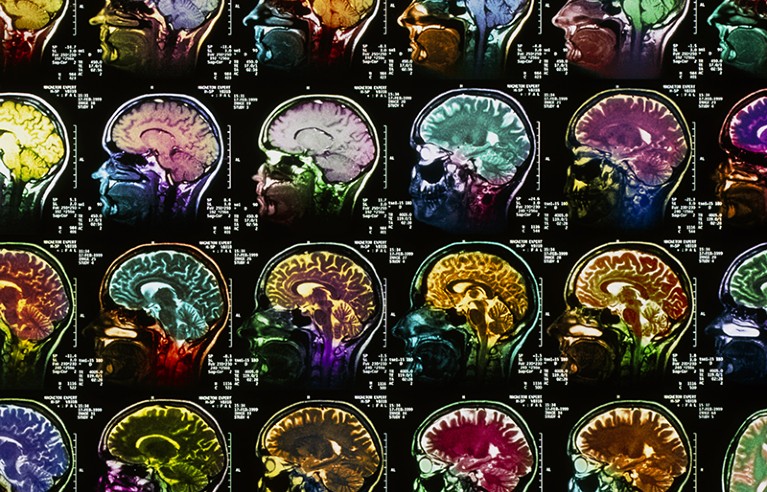
Magnetic resonance imaging scans of the human brain.Credit: Simon Fraser/SPL/Getty
The Inflamed Mind: A Radical New Approach to Depression Edward Bullmore Short (2018)
Depression affects one in four people at some time in their lives. It is often difficult to treat, in part because its causes are still debated. Psychiatrist Edward Bullmore is an ardent proponent of a radical theory now gaining traction: that inflammation in the brain may underlie some instances. His succinct, broad-brush study, The Inflamed Mind, looks at the mounting evidence.
The book outlines a persuasive case for the link between brain inflammation and depression. Bullmore pleads with the medical profession to open its collective mind, and the pharmaceutical industry to open its research budget, to the idea. He provides a current perspective on how the science of psychiatry is slowly emerging from a decades-long torpor. He sees the start of a shift in the Cartesian view that disorders of the body ‘belong’ to physicians, whereas those of the more ‘immaterial’ mind ‘belong’ to psychiatrists. Accepting that some cases of depression result from infections and other inflammation-causing disorders of the body could lead to much-needed new treatments, he argues.
In 1989, during his clinical training at St Bartholomew’s Hospital in London, Bullmore encountered a patient whom he calls Mrs P, who had severe rheumatoid arthritis. She left an indelible impression. He examined her physically and probed her general state of mind. He reported to his senior physician, with a certain pride in his diagnostic skill, that Mrs P was both arthritic and depressed. Replied the experienced rheumatologist dismissively, given her painful, incurable physical condition, “You would be, wouldn’t you?”
Mrs P is a recurring motif, as is the rhetorical question. Bullmore draws on more than two millennia of medical history — from ancient Greek physician Hippocrates to the work of neuroanatomist and 1906 Nobel laureate Santiago Ramón y Cajal — to illustrate his points. At times they seem like intellectual meanderings, but these passages also show how medical science often progresses by means of bold theories that break away from received wisdom.
After his training, Bullmore specialized in psychiatry, and quickly experienced its limitations. He describes his growing awareness of how poorly science has served the field, using the development of selective serotonin reuptake inhibitors (SSRIs) as a prime example.
That long and winding road began with the antibiotic iproniazid. It was discovered through scientific logic: by screening chemicals for their ability to kill Mycobacterium tuberculosis in the test tube and in mice. Iproniazid transformed the treatment of tuberculosis in the 1950s. Patients clawed back from the jaws of death exhibited euphoria — well, you would, wouldn’t you? — and the drug was soon launched as an antidepressant. Soon the theory emerged (based more on supposition than evidence, says Bullmore) that its psychiatric effects were the result of boosting the neurotransmitters adrenaline and noradrenaline. Drug developers began to focus on neurotransmission more broadly.
Prozac (fluoxetine), which boosts serotonin transmission, was launched in the mid-1980s, and many pharmaceutical companies quickly followed with their own SSRIs. It seemed to be the revolution psychiatrists had been waiting for. But it soon emerged that only a modest subset of patients benefited (estimates based on trials vary widely). That is unsurprising in retrospect, with the new appreciation that depression can have many causes. Bullmore holds that the emergence of SSRIs bypassed scientific logic. The serotonin theory, he writes, is as “unsatisfactory as the Freudian theory of unquantifiable libido or the Hippocratic theory of non-existent black bile”. He notes that, after SSRIs failed to live up to the hype, time once again stood still for psychiatry.
Bullmore recalls a teleconference in 2010, when he was working part-time with British pharmaceutical giant GlaxoSmithKline. During the call, the company announced it was pulling out of psychiatry research because no new ideas were emerging. In the following years, almost all of ‘big pharma’ abandoned mental health.
Then a window seemed to open — one that shed a different light on the plight of Mrs P. Some of the textbook certainty that Bullmore had learnt by rote at medical school started to look distinctly uncertain.
In particular, the blood–brain barrier turned out to be less impenetrable than assumed. A range of research showed that proteins in the body could reach the brain. These included inflammatory proteins called cytokines that were churned out in times of infection by immune cells called macrophages. Bullmore pulls together evidence that this echo of inflammation in the brain can be linked to depression. That, he argues, should inspire pharmaceutical companies to return to psychiatry.
It seems unfair that someone struck down by infection should have depression too. Is there a feasible evolutionary explanation? Bullmore hazards that depression would discourage ill individuals from socializing and spreading an infection that might otherwise wipe out a tribe.
Other brain disorders might turn out to be prompted or promoted by inflammation. An exciting link with neurodegenerative diseases, including Alzheimer’s, is also being studied (see Nature 556, 426–428; 2018). But we need to learn from the rollercoaster history of brain research, and keep expectations in check. Beneath his bombastic enthusiasm, Bullmore acknowledges this, too.

 Nature special: Depression
Nature special: Depression
 Is ‘friendly fire’ in the brain provoking Alzheimer’s disease?
Is ‘friendly fire’ in the brain provoking Alzheimer’s disease?
 A very sad story
A very sad story
 Inside the fear factor
Inside the fear factor







